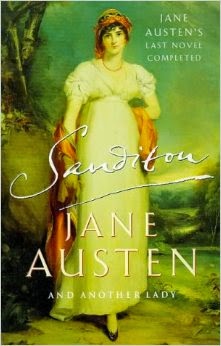A confusion in address and a carriage accident leads to the introduction of Mr Tom Parker and his wife Mary to the Heywood family. Mr Parker injures his ankle and being friendly people, Mr Heywood invites the Parkers to stay until the ankle injury has healed. Mr and Mrs Parker wish to return the civility by inviting the Heywood family to stay with them at their home in the seaside resort of Sanditon. The Heywoods won’t agree to all go, but eldest daughter Charlotte, who in her early 20s, sets off for Sanditon with the Parkers. Mr Parker’s favourite subject is Sanditon, which he has invested in and hopes to see become a fashionable resort. He is a little ridiculous in his fulsome praise of the place, stating that it can cure every ailment:
‘The sea air and sea bathing together were nearly infallible, one or the other of them being a match for every disorder of the stomach, the lungs or the blood. They were anti-spasmodic, anti-pulmonary, anti-septic, anti-bilious and anti-rheumatic.’Charlotte is introduced to the society in Sanditon, who are a very interesting selection of people. Firstly there is the grande dame of Sanditon, Lady Denham, who is a very contrary lady – she is stingy but she is also interested in making Sanditon a fashionable location, so the Parkers are keen to remain on terms with her. Her favour is also being courted by relatives of her late husband, the supercilious Miss Denham, and her brother, Sir Edward Denham, who is one of the most ridiculous characters I’ve ever come across. Imagine a man who has all of Catherine Morland’s love of gothic novels, but is old enough to know better. He is without sense, full of conceit, and fancies himself as a gallant. He has a tendency to misquote poetry... badly. And he will not use one word where fifteen will suffice:
‘He sought to entertain them with his longest syllables and most edifying sentences.’In addition to these characters, we also have Mr Parker’s siblings, who all come to visit during Charlotte’s stay. Three of them are great invalids, or fancy themselves as such, but all the Parkers share a trait of being very enthusiastic about their pet projects. Mr Parker has Sanditon, while the others have illness, being a busybody, seaweed and directing the course of events to fill their time.
I really liked Charlotte as a heroine. Amongst such oddbods her normality shone through. She is sensible and unromantic, but this doesn’t mean her heart is safe from being touched. Charlotte is much more perceptive than the other inhabitants of Sanditon, and she picks up on intrigues that most people there are unaware of. She also has a bit of a lack of self-esteem and she is by no means vain. I don’t want to tell you too much about the plot, but there are some intrigues afoot, some villainy planned and quite a bit of manipulation of others for their own good going on, and our dear Charlotte will be observing and trying to understand it all.
As for the join between Austen’s work and that of the other author (Marie Dobbs, who also wrote under the name Anne Telscombe), I didn’t notice it either, but over the course of the book I felt that it began to feel more and more modern. The characters frankness with each other surprised me, as did some of the events. As the plot moved on I felt it moved further and further away from an Austen novel. This isn’t to say that I didn’t enjoy it. I enjoyed the book very much, and found myself thinking of it when I wasn’t reading it, but I think it’s a safe bet to say that Austen wouldn’t have ended the book this way. It felt more in the style of Georgette Heyer than Austen to me. In fact, Charlotte reminded me a little of Ancilla Trent in ‘The Nonesuch’ by Georgette Heyer because she was so much more aware of what was going on than the other people staying in Sanditon, and Charlotte’s relationship with the hero also reminded me of this book. This was a wonderfully entertaining read and I’d recommend it. I’d rate this as a five star read.



Made my comments over at Good Reads. But, again, glad you enjoyed this one.
ReplyDeleteThank you, Sophia :)
DeleteYAY! Loved your review, Ceri! This ons is a favorite of mine - I think it might have been the third or fourth Austenesque novel I've ever read. I completely agree with you about it feeling more modern and more Heyer by the end. I love Charlotte and Sidney, such interesting and likable characters! Such a shame Jane Austen never got to complete this promising work!
ReplyDeleteI really liked both Charlotte and Sidney too. Have you read any other Sanditon completions, Meredith? I would love to know how Jane Austen would have finished it!
Delete